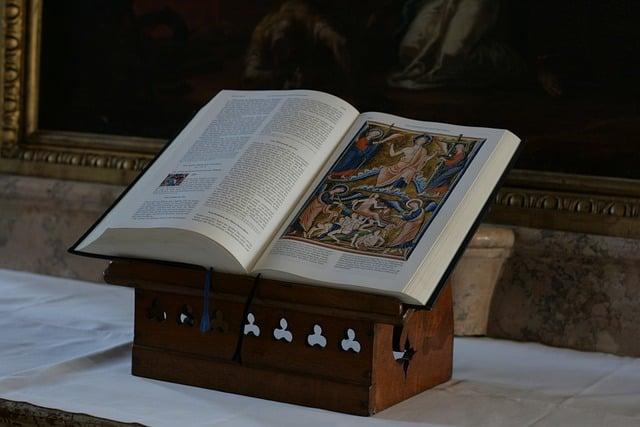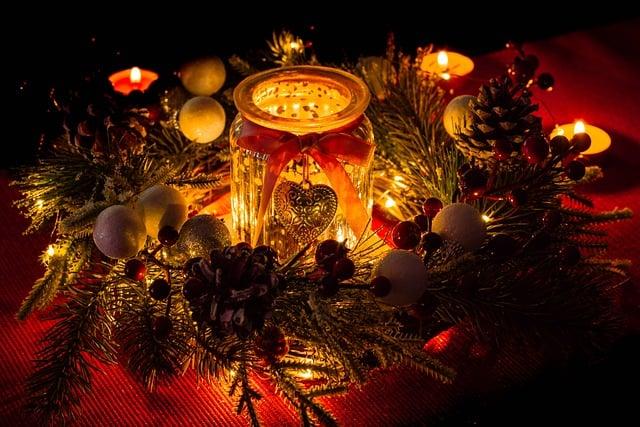In a quaint village, nestled among snow-capped hills, a young girl named Clara hung a vibrant Christmas wreath on her door. Each green leaf whispered tales of hope and renewal, while the red berries sparkled like the joy of the season. One evening, her grandmother shared a story: “The wreath symbolizes eternal life, much like the promise of Christ’s birth.” Clara’s eyes widened, realizing that this simple decoration held deeper meaning. As the village gathered to celebrate, the wreath became a beacon of love, reminding all of the true spirit of Christmas.
Table of Contents
- Exploring the Symbolism of Christmas Wreaths in Biblical Context
- The Historical Roots of Wreaths and Their Connection to Christian Traditions
- Crafting a Meaningful Christmas Wreath: Tips for Incorporating Scripture
- Celebrating the Season: How to Use Wreaths as a Reflection of Faith
- Q&A

Exploring the Symbolism of Christmas Wreaths in Biblical Context
Christmas wreaths, often adorned with vibrant colors and festive decorations, carry a deeper significance that resonates with biblical themes. The circular shape of the wreath symbolizes **eternity**, reflecting the unending love of God and the promise of eternal life through Christ. In the Bible, the concept of eternity is woven throughout scripture, reminding believers of the everlasting covenant established through Jesus’ birth, death, and resurrection. The use of evergreens in wreaths, which remain green throughout the seasons, further emphasizes **renewal** and **hope**, paralleling the message of salvation and the new life offered to all who believe.
Additionally, the act of hanging a wreath on a door serves as a **symbol of welcome** and hospitality, echoing the biblical call to love and serve others. In the Gospel of Matthew, Jesus teaches about the importance of welcoming the stranger and providing for those in need. A wreath can thus be seen as an invitation to share the joy of the season and the message of Christ’s love with family, friends, and neighbors. As we decorate our homes with these circular symbols, we are reminded of the **community** and **togetherness** that the Christmas season fosters, encouraging us to reflect on the true spirit of giving and grace that the holiday embodies.

The Historical Roots of Wreaths and Their Connection to Christian Traditions
The tradition of wreath-making can be traced back to ancient civilizations, where circular shapes symbolized eternity and the cyclical nature of life. In Roman culture, wreaths were often made from laurel leaves and used to crown victors in athletic competitions, while in ancient Greece, they were associated with the gods and used in various religious ceremonies. As Christianity spread throughout Europe, these circular decorations began to take on new meanings, particularly during the Advent season. The use of evergreen materials in wreaths became a powerful symbol of hope and renewal, representing the everlasting life offered through Christ. The circular form of the wreath itself came to signify God’s unending love and the eternal nature of faith.
In Christian traditions, wreaths are often adorned with candles, each representing a different aspect of the Advent season. The **four candles** typically symbolize hope, peace, joy, and love, while the **central white candle** represents Christ himself, often lit on Christmas Day. This practice not only enhances the spiritual atmosphere of the holiday but also serves as a reminder of the light that Jesus brings into the world. As families gather around their Advent wreaths, they engage in a meaningful ritual that connects them to centuries of Christian heritage, reinforcing the significance of the season and the anticipation of Christ’s birth. The wreath thus becomes a beautiful blend of historical roots and spiritual significance, enriching the celebration of Christmas in homes around the globe.

Crafting a Meaningful Christmas Wreath: Tips for Incorporating Scripture
Creating a Christmas wreath that resonates with the spirit of the season can be a beautiful way to incorporate your faith into your holiday decor. One effective approach is to select scripture verses that reflect themes of hope, love, and joy. Consider using **Isaiah 9:6**, which speaks of the coming of Christ as a wonderful counselor and prince of peace. You can write this verse on a decorative tag and attach it to your wreath, allowing it to serve as a daily reminder of the true meaning of Christmas. Additionally, **Luke 2:10-11** can be a wonderful addition, celebrating the birth of Jesus and the joy it brings to the world.
To enhance the visual appeal of your wreath while embedding scripture, think about incorporating elements that symbolize these verses. For instance, you might use **pinecones** to represent the beauty of creation, or **red berries** to symbolize the blood of Christ and His sacrifice. You could also add **gold ribbons** to signify the royalty of Jesus as the King. As you craft your wreath, let your creativity flow by intertwining these elements with the chosen scripture, creating a piece that not only adorns your home but also serves as a heartfelt expression of your faith during the Christmas season.

Celebrating the Season: How to Use Wreaths as a Reflection of Faith
Wreaths have long been a symbol of the season, embodying the spirit of celebration and reflection. In many cultures, they represent eternity, with their circular shape signifying the unending love of God. As we adorn our homes with these beautiful creations, we can infuse them with elements that reflect our faith. Consider incorporating **evergreen branches**, which symbolize everlasting life, or **red berries**, representing the blood of Christ and the joy of salvation. Each element can serve as a reminder of the deeper meanings behind the holiday, inviting us to pause and reflect on the true essence of Christmas.
Moreover, wreaths can be personalized to tell our unique stories of faith. Adding **ornaments that represent personal milestones** or **scripture verses** can transform a simple decoration into a powerful testament of our journey with God. For instance, a wreath adorned with **angels** can remind us of the heavenly hosts that proclaimed Christ’s birth, while **stars** can symbolize the guiding light of faith in our lives. By using wreaths as a canvas for our beliefs, we not only celebrate the season but also create a visual representation of our spiritual journey, inviting others to share in the joy and hope that Christmas brings.
Q&A
-
What is the significance of Christmas wreaths in Christianity?
Christmas wreaths symbolize eternal life and the unending love of God. The circular shape represents God’s infinite nature, while the greenery signifies renewal and hope, aligning with the themes of the Christmas season.
-
Are Christmas wreaths mentioned in the Bible?
While Christmas wreaths themselves are not specifically mentioned in the Bible, the use of greenery and decorations during festive seasons can be seen as a way to celebrate the birth of Jesus and the joy of the season.
-
What materials are traditionally used in Christmas wreaths?
Traditional Christmas wreaths are often made from evergreen branches, which symbolize life. They may also include elements like holly, pinecones, and ribbons, each carrying its own meaning related to the season.
-
Can Christmas wreaths be used in religious settings?
Yes, Christmas wreaths can be used in religious settings as a decorative element that enhances the celebration of Christmas. They can serve as a reminder of the themes of hope, joy, and the promise of eternal life found in Christian teachings.
In exploring the significance of Christmas wreaths through a biblical lens, we uncover layers of meaning that enrich our holiday traditions. As you hang your wreath this season, may it serve as a reminder of hope, love, and the enduring spirit of Christmas.

大家好,我是彼得潘,專業的手法身體治療師。我喜歡探索和研究各種主題,並透過與人工智慧的合作分享專業、實用、有趣的文章。我們定期進行人工審核,以確保內容的準確性。如果您發現文章中有任何不準確的地方,請隨時與我們聯繫,我們會及時糾正。您可以透過 [email protected] 與我們聯繫。



